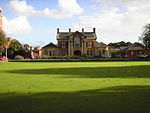Velindre Cancer Centre
1956 establishments in WalesCancer hospitalsHospital buildings completed in 1956Hospitals established in 1956Hospitals in Cardiff ... and 1 more
NHS hospitals in Wales

The Velindre Cancer Centre (Welsh: Canolfan Ganser Felindre) is a specialist facility caring for cancer patients in Whitchurch, Cardiff, Wales. It is managed by the Velindre University NHS Trust.
Excerpt from the Wikipedia article Velindre Cancer Centre (License: CC BY-SA 3.0, Authors, Images).Velindre Cancer Centre
Velindre Road, Cardiff Coryton
Geographical coordinates (GPS) Address Phone number Website External links Nearby Places Show on map
Geographical coordinates (GPS)
| Latitude | Longitude |
|---|---|
| N 51.5163 ° | E -3.2283 ° |
Address
Velindre Cancer Centre (Velindre Hospital)
Velindre Road
CF14 2TL Cardiff, Coryton
Wales, United Kingdom
Open on Google Maps











